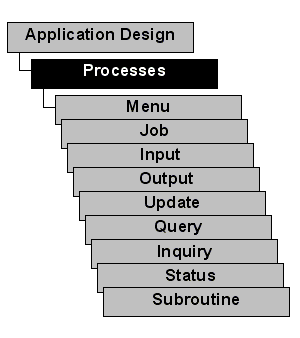Chapter 1-4: Understanding Process Design |
Processes Compared With Programs A process is very similar to a program in traditional data processing systems, in that: You execute a process to perform one or more related functions or activities. A process is the smallest unit of an application that can be executed separately. A process consists of a series of detailed instructions performed in a specified sequence. These instructions consist of process specifications, their associated painted images, data dictionary references, and ILF routines. APPX compiles the process source specifications into instructions more suitable for machine execution. There are, however, some significant differences between a process and a traditional program, including the following: A program consists entirely of line-by-line procedural coding, while a process is comprised of an integrated set of specifications. You must compile a program as a separate step before executing it but a process is compiled automatically at runtime, if required. A program must include a detailed definition of the files and fields that are referenced, whereas all data referenced by a process (including local temporary data) is defined in the data dictionary. In a program, you must explicitly control when each instruction is executed, while an APPX process automatically executes based on the specifications. You use a standard editor to develop and modify a program, while in APPX you use the specification screens to guide development. Each program represents a separate file, but all the processes for an entire application are stored in a set of APPX design files. You access the process definition facility from the Application Design menu. The first screen you see allows you to specify the type and name of the process you are defining or editing. After you identify the process, you see displayed the remainder of the specifications that are applicable to the type of process (menu, input, etc) you selected. From this point on, APPX moves you automatically through the family of screens that comprise the process definition facility. On the facing page is a schematic diagram of the process definition design components.
The Process Family |
Application Design Manual "Powered by Appx Software"62 ©2006 By APPX Software, Inc. All Rights Reserved |
